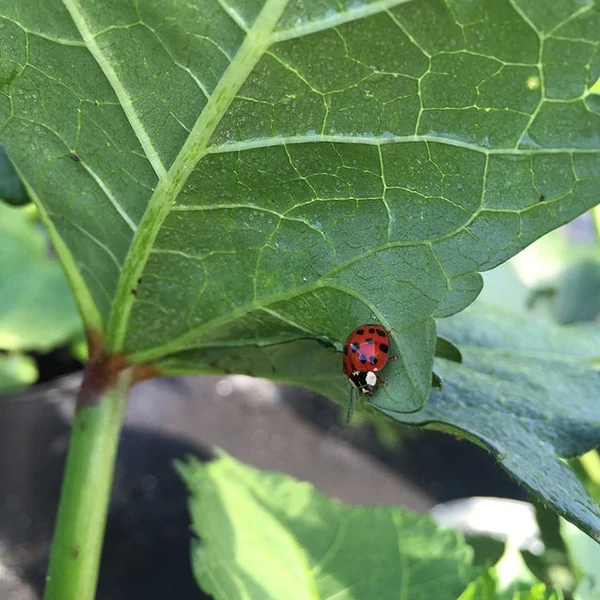by Amanda Rose Newton
Without a doubt, ladybugs (a beetle, NOT a bug) are the most recognizable “good bug” around. It is no wonder that the cups of live ladybugs we sell happen to be one of our most requested items!
If you are a regular in our garden center, you may have noticed a drop off in the availability of ladybugs from about now until later in the fall. This is due to Florida’s intense heat, which makes it difficult for out of state ladybugs to arrive safe and alive.

If you are currently in the midst of an aphid invasion, do not despair! You can attract native ladybugs to your garden by simply choosing plants that are natural attractants.
Not only will your yard be enticing to ladybugs, but likely to many other members of the ladybug family tree (Coccinellidae) who will work on keeping your garden safe from season to season.
Keep in mind, adult and juvenile ladybugs consume different foods, so offering up a wide variety of plants will keep everyone happy and around for the long term.
Ladybugs are predators, which means they prefer eating other insects, especially during their larval (teenage) stage. The more sophisticated adults do get some variety in their diet and enjoy pollen as a snack between meals.
If you already have plants infested with pests (aphids are the favorite), adding in some pollen producers will invite the ladybugs to move in.
As a rule, ladybugs prefer flowers that are light in color, are flat enough for them to land on easily, and are heavily scented.
Refer to the list below for plants that will encourage ladybugs to move into your own home garden.
Ladybugs Most Loved List:
- Cilantro
- Chives
- Cosmos
- Dill
- Fennel
- Sweet Alyssum
- Marigold
- Geraniums
- Coreopsis
- Mint
- Dandelions
- Parsley
- Gardenia
- Azalea
- Grapes
- Melons
- Hibiscus
- Mustard
- Papaya
- Strawberries
- Sunflower
- Roses
- Milkweed (when in bloom and in case of heavy infestation of aphids)
As you can gather from the list, plants that smell strongly tend to be magnets for common pests that will likely attract ladybugs. In addition to upping your flowers and herbs, you can offer up a treat of honey blended with a little water in a saucer to entice those present to stay.
Additional Tips for Creating a Ladybug Haven
- Use fewer pesticides! Most chemical insecticides are broad spectrum, meaning they kill a wide variety of insects including your new ladybug friends. Take a break from pesticides and add flowers instead!
- Add Water. Ladybugs are animals and can go much longer without food than water. Having an available water source is key in getting them to stick around. If you do not live near a pond or have a bird bath, try adding a small amount of water to a saucer to keep nearby well-visited plants. Just keep it on the shallow side so mosquitoes do not become frequent guests!
- Room and Board. Ladybug houses are popular mainstays at craft fairs and specialty nature shops. Like birdhouses, they offer a place to shelter for visiting ladybugs. However, just like birds, ladybugs may or may not end up checking in, but it doesn’t hurt to offer!
- Meet the Family. The larval form of ladybugs does not resemble the adults at all! Make sure you take the time to properly identify the egg, larva, pupa, and adult stage to ensure you do not accidently off one of the good guys!
If you do decide to release ladybugs in your yard, keep in mind it will take them a bit to adjust to the new surroundings. Releasing them at the right time of day (dusk or dawn- not in the blazing sun of the afternoon) and when they have been chilled in the fridge for a few hours usually helps prevent them from taking off onto the horizon. Placing them near a targeted area will also assist in getting them to their desired food and water source faster and easier, which, at the end of the day, is what will get them to stay.


